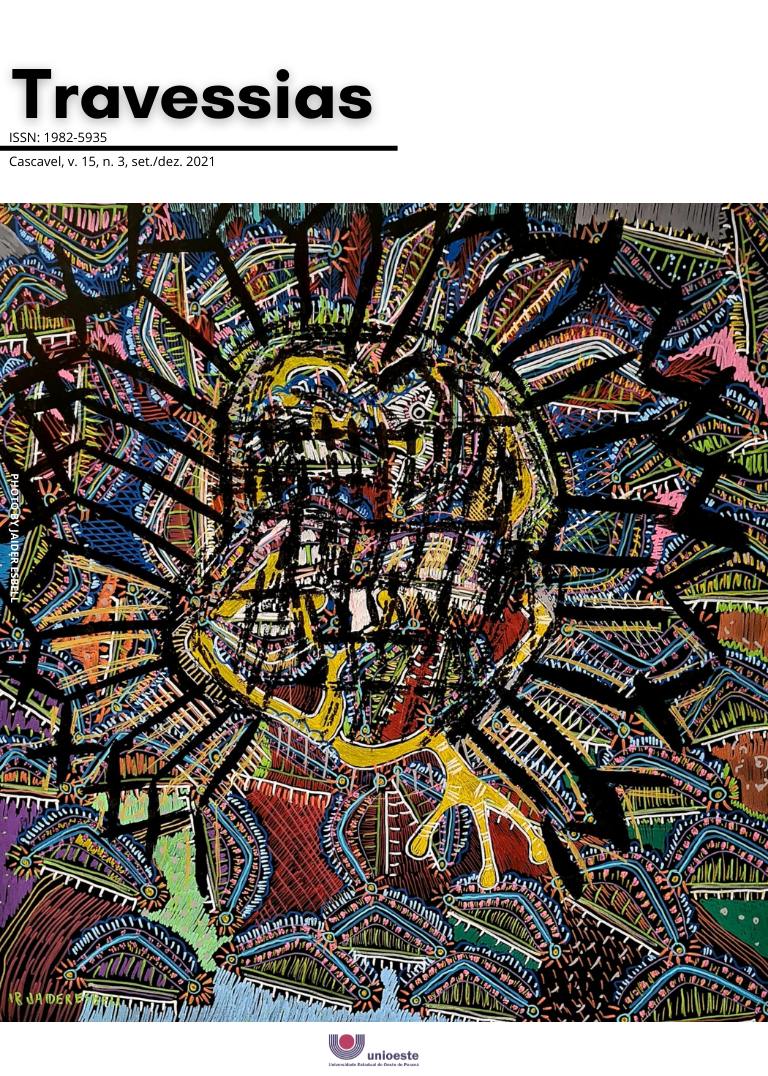Gestos de interpretação em atividade de leitura da letra da música “Mulheres de Atenas”
DOI:
https://doi.org/10.48075/rt.v15i3.27219Palavras-chave:
Práticas Discursivas, Letra de Música, “Mulheres de Atenas”Resumo
Este artigo é o relato de uma atividade de leitura que aborda a identidade da mulher. Nosso objetivo é analisar as discursividades que compõem respostas de alunos e que produzem sentidos acerca da condição da mulher retratada na letra da música “Mulheres de Atenas” de Buarque e Boal (1976). Ao trazer questões sociais para o contexto de sala de aula, levamos em conta a importância crescente das lutas por direitos de grupos minoritários, dentre os quais se destacam os debates sobre a identidade da mulher. Utilizamos os conceitos da Análise de Discurso de linha francesa, como formação discursiva, efeitos de sentido, interdiscurso e sujeito, baseados em autores como Althusser (1970), Authier-Revuz (2004), Brandão (2004), Pêcheux (1978) e Orlandi (2009), entre outros. A geração dos dados foi feita por meio de um questionário aplicado a uma turma de 7º ano do Ensino Fundamental regular, com auxílio da ferramenta Google Forms e do aplicativo de aparelhos celulares WhatsApp, entre junho e julho de 2019. Gestos de leitura da composição musical apontaram para a constituição discursiva de diversos sujeitos, evidenciando sempre a presença de um outro, num interdiscurso que implica um lugar social e uma constituição identitária transitória, afirmando ora a adolescência, ora a condição adulta, ora o estudante, ora o trabalhador que concorre por trabalho no mercado. Nas palavras dos respondentes ao questionário, identificamos a percepção de violências contra a mulher, da subordinação aos maridos à ausência de reconhecimento por seu trabalho, desumanização e objetificação.
Downloads
Referências
ALTHUSSER, Louis. Ideologia e aparelhos ideológicos do Estado. Trad. Joaquim José de Moura Ramos. Lisboa: Editorial Presença/Martins Fontes, [1970].
AUTHIER, Jacqueline. Palavras mantidas à distância. In: CONEIN, Bernard et al. Materialidades discursivas. Campinas, SP: Editora da Unicamp, 2016. p. 201-226.
AUTHIER-REVUZ, Jacqueline. Entre a transparência e a opacidade: um estudo enunciativo do sentido. Porto Alegre: EDIPUCRS, 2004.
BRANDÃO, Helena Hathsue Nagamine. Introdução à análise do discurso. 2. ed. rev. Campinas: Editora da Unicamp, 2004.
BRASIL. Secretaria de Educação Fundamental. Parâmetros curriculares nacionais: terceiro e quarto ciclos do ensino fundamental: língua portuguesa. Brasília: MEC/SEF, 1998.
BRASIL. Ministério da Educação. Base nacional comum curricular. Brasília: MEC/Consed/Undime, 2018. Disponível em: http://basenacionalcomum.mec.gov.br/. Acesso em: 4 jan. 2019.
BUARQUE, Chico; BOAL, Augusto. Mulheres de Atenas. Fotocópia de documento sob a guarda do Arquivo Nacional contendo a letra e o Parecer da censura da música pelo Serviço de Censura de Diversões Públicas em 1976. In: WIKIPÉDIA. Mulheres de Atenas [verbete]. Disponível em: https://pt.wikipedia.org/wiki/Mulheres_de_Atenas. Acesso em: 9 out. 2021.
CEREJA, William Roberto; MAGALHÃES, Thereza Cochar. Português: linguagens. 9. ed. reform. São Paulo: Saraiva, 2015.
FOUCAULT, Michel. A ordem do discurso. São Paulo: Edições Loyola, 1996.
HALL, Stuart. A identidade cultural na pós-modernidade. Rio de Janeiro: DP&A, 2006.
ORLANDI, Eni Puccinelli. Análise de discurso: princípios & procedimentos. Campinas: Pontes, 2009.
PÊCHEUX, Michel. Hacia el análisis automático del discurso. Trad. Manuel Alvar Ezquerra. Madrid: Editorial Gredos, 1978.
RUSSO, Victor. Streamers X Youtubers: qual é a diferença? inFluu. Disponível em: https://influu.me/blog/streamers-x-youtubers-qual-e-a-diferenca. Acesso em: 5 jul. 2019.
Downloads
Publicado
Como Citar
Edição
Seção
Licença
Copyright (c) 2021 Autores mantêm os direitos autorais e concedem à revista o direito de primeira publicação, com o trabalho simultaneamente licenciado sob CC-BY-NC-SA 4.0 que permite o compartilhamento do trabalho com indicação da autoria e publicação inicial nesta revista

Este trabalho está licenciado sob uma licença Creative Commons Attribution-NonCommercial-ShareAlike 4.0 International License.
Aviso de Direito Autoral Creative Commons
Política para Periódicos de Acesso Livre
Autores que publicam nesta revista concordam com os seguintes termos:
1. Autores mantêm os direitos autorais e concedem à revista o direito de primeira publicação, com o trabalho simultaneamente licenciado sob a Licença Creative Commons Attribution que permite o compartilhamento do trabalho com reconhecimento da autoria e publicação inicial nesta revista.
2. Autores têm autorização para assumir contratos adicionais separadamente, para distribuição não-exclusiva da versão do trabalho publicada nesta revista (ex.: publicar em repositório institucional ou como capítulo de livro), com reconhecimento de autoria e publicação inicial nesta revista.
3. Autores têm permissão e são estimulados a publicar e distribuir seu trabalho online (ex.: em repositórios institucionais ou na sua página pessoal) a qualquer ponto antes ou durante o processo editorial, já que isso pode gerar alterações produtivas, bem como aumentar o impacto e a citação do trabalho publicado (Veja O Efeito do Acesso Livre).
Licença Creative Commons
Esta obra está licenciada com uma Licença Creative Commons Atribuição-NãoComercial-CompartilhaIgual 4.0 Internacional, o que permite compartilhar, copiar, distribuir, exibir, reproduzir, a totalidade ou partes desde que não tenha objetivo comercial e sejam citados os autores e a fonte.



